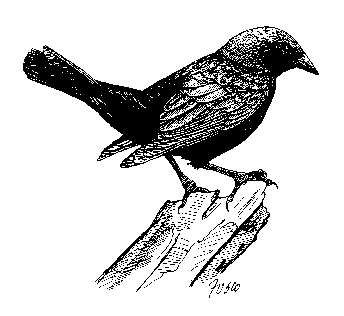Brown-headed Cowbird
Molothrus ater
Habitat: Farmland, grassland, forest edge, deciduous woodland.
Size: 7 inches.
Weight: 1 to 1.75 ounces; females are smaller.
Diet: Corn; wheat; oats; grasses; seeds; soft mast such as black cherries, blackberries and wild grapes; and invertebrates including grasshoppers, beetles, caterpillars and other insects, land snails and spiders.
Identification: The brown-headed cowbird is a member of the diverse blackbird family. Males are glossy black but have a brown head. Females are brownish gray. Juveniles are also gray but their breasts are streaked and lighter in appearance. All have a stout finch-like beak.
Range: Brown-headed cowbirds are found from Saskatchewan and southern Canada, through the lower 48 states and into northern Mexico. They are migratory and arrive in Connecticut in March, remain through the summer and leave in late-September. A few, however, remain in Connecticut throughout the year.
Reproduction: In Connecticut, cowbirds display courtship behavior in March and early April. Female cowbirds have specific breeding territories and males will visit to sing, display and compete for the females. Males will display from an elevated perch, such as a tree branch, and tilt their bill up or fluff out their upper body feathers, spread their wings and tail and dip forward. They may also display in the air and on the ground.
In mid-May, the female will begin laying her eggs. She does not construct her own nest but instead lays her eggs in the nests of other birds. Some host nests will support more than one cowbird egg, each laid by different individuals. To find a host nest, the female cowbird will sit on a high perch in a forest opening to watch for nest-building birds. Once a nest is chosen, the cowbird female will either eat or destroy one of the host's eggs before quickly laying one of her own. Cowbird eggs are gray with brown markings and are usually unlike the smaller host eggs; nonetheless the foster parent will brood them all. Cowbirds develop rapidly and hatch in 10 to 13 days, which is usually one to six days before the others in the nest. They immediately begin their relentless request for food. The voracious appetite of the cowbird can tire the host parent as she tries to keep up with its demands. The other young birds in the nest are often crowded by the larger cowbird and neglected by the parent bird. The food begging sometimes does not end when the cowbird leaves the nest as the parent bird is often seen frantically searching for additional food to feed the fledgling. Amazingly, studies have shown that only three percent of cowbird eggs hatch and survive to adulthood. However, one female cowbird can produce from 30 to 40 eggs each nesting season which more than makes up for the low survival rate to adulthood.
History in Connecticut: Originally found only in the prairies of the Midwest, cowbirds have extended their range and now occur in Connecticut. This range expansion has resulted in part from land use practices during the 1700s and 1800s when forests were cleared to create pastures and farmland, both ideal habitat types for cowbirds. Subsequently, the edge habitat between forest and grassland became a preferred habitat type. In Connecticut, cowbirds are numerous and occur throughout the state during the breeding season.
Interesting Facts: Cowbirds traditionally followed bison to feast on the insects flushed from the ground as these large animals travelled during their seasonal migrations. This led to the regional names of buffalo bird, cowbunting, cow blackbird and lazy bird.
The brown-headed cowbird is probably best known for its parasitic egg-laying behavior. Although over 200 different types of birds are known to have nests parasitized by the brown-headed cowbird, some birds, such as the common tern, a few species of sandpipers, killdeer, ruby-throated hummingbird and red-headed woodpecker, fail as foster parents. Others with large bills, such as bluejays, catbirds and robins, will cast out the "foreign" egg. A few birds abandon the nest site or rebuild a new nest on top of the old. Close to 150 species can be suitable foster parents, accepting the egg in their nest, brooding it and later feeding the young.
Cowbirds differ from the infamous parasitic bird, the European cuckoo, in that cowbird eggs do not look at all like host eggs while European cuckoo eggs closely resemble host eggs. Connecticut's native cuckoos, the black-billed and yellow-billed are only occasionally parasitic and usually only lay eggs in the nests of other individuals of the same species.
Like other blackbirds, cowbirds can sometimes form large overwintering flocks for feeding and roosting.
Management of Nuisances: The brown-headed cowbird is a native bird and protected under the Migratory Bird Treaty Act. Under the law, it cannot be taken except for scientific or propagating purposes under permits. Special permits may be issued if cowbird parasitism is having a significant impact on an endangered species. Cowbirds were actively trapped and removed by natural resource agencies in an effort to lessen their impact on endangered black-capped vireos (Texas) and Kirtland's warblers (Michigan).
 The Technical Assistance
Informational Series is 75 percent funded by Federal Aid to Wildlife Restoration -
Pittman-Robertson (P-R) Program. The P-R Program provides funding through an excise tax on
the sale of sporting firearms, ammunition, and archery equipment. The remaining 25 percent
of the funding is matched by the Connecticut Wildlife Division. (rev. 12/99)
The Technical Assistance
Informational Series is 75 percent funded by Federal Aid to Wildlife Restoration -
Pittman-Robertson (P-R) Program. The P-R Program provides funding through an excise tax on
the sale of sporting firearms, ammunition, and archery equipment. The remaining 25 percent
of the funding is matched by the Connecticut Wildlife Division. (rev. 12/99)

